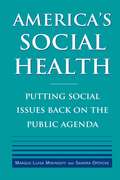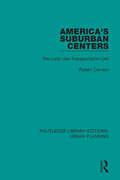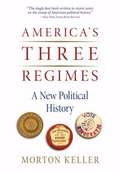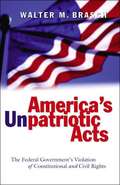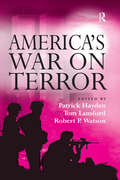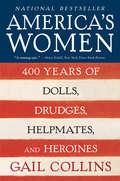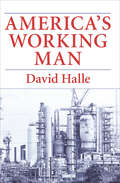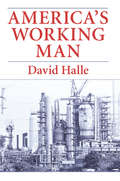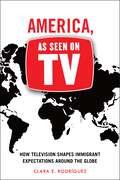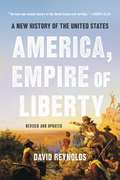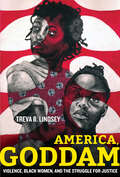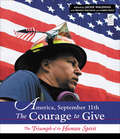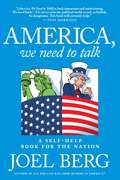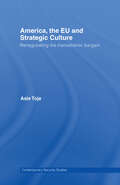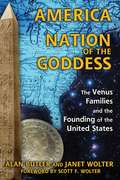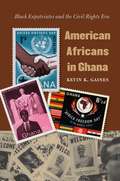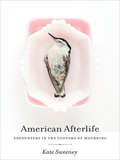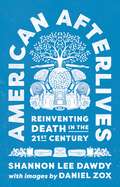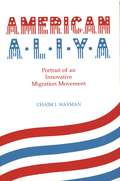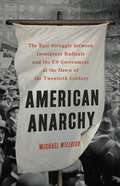- Table View
- List View
America's Social Health: Putting Social Issues Back on the Public Agenda
by Sandra Opdycke Marque-Luisa MiringoffCalling for a fundamental change in the focus of public policy in America, this book paints a vivid portrait of the nation's social health. Miringoff and Opdycke clearly show that social progress has stalled and the country's energies need to be directed at critical domestic issues in the years ahead.The authors propose a new agenda for monitoring America's social well-being built around sixteen key indicators of American life, such as infant mortality, teenage suicide, health insurance coverage, and affordable housing. They maintain that social conditions, like economic conditions, must be constantly monitored in order to have a clear sense of "how we are doing" as a society.The book builds on the work of the Institute for Innovation in Social Policy and argues that there needs to be a greater visibility for social issues - and a closer link between social reporting and public action - to better address the nation's social problems. It considers the critical role of the media in advancing public understanding of social issues, and examines important advances in the community indicators movement and international social reporting. Eye-opening and compelling, the book is a provocative centerpiece for policy debates and national initiatives on today's crucial domestic concerns.
America's Suburban Centers: The Land Use-Transportation Link (Routledge Library Editions: Urban Planning #6)
by Robert CerveroOriginally published in 1989, America’s Suburban Centers looks at how America’s suburban workplaces are being increasingly designed for automobiles rather than people. The emergence of sprawling office complexes devoid of housing, shops and other facilities is giving rise to regional congestion problems because of the ever-greater dependence on automobiles. This book argues that the low-density, single-use, and non-integrated character of America’s suburban centers is a root cause of declining levels of mobility and worsening traffic congestion.
America's Three Regimes: A New Political History
by Morton KellerHailed in The New York Times Book Review as "the single best book written in recent years on the sweep of American political history," this groundbreaking work divides our nation's history into three "regimes," each of which lasts many, many decades, allowing us to appreciate as never before the slow steady evolution of American politics, government, and law. The three regimes, which mark longer periods of continuity than traditional eras reflect, are Deferential and Republican, from thecolonial period to the 1820s; Party and Democratic, from the 1830s to the 1930s; and Populist and Bureaucratic, from the 1930s to the present. Praised by The Economist as "a feast to enjoy" and by Foreign Affairs as "a masterful and fresh account of U. S. politics," here is a major contribution to the history of the United States - an entirely new way to look at our past, our present, and our future - packed with provocative and original observations about American public life.
America's Unpatriot Acts: The Federal Government's Violation of Constitutional and Civil Rights
by Walter M. BraschWithin six weeks of the 9/11 terrorist attacks, Congress approved the USA Patriot Act, drafted in secret by the Department of Justice. Brasch, an award-winning syndicated columnist and university professor, looks at the effects of the Patriot Act on the nation and at the many civil rights violations conducted in the US, and by the US in foreign countries, during the three years after 9/11. Annotation ©2004 Book News, Inc., Portland, OR (booknews.com)
America's War on Terror
by Tom Lansford Patrick HaydenThis title was first published in 2003. 9/11 has become more than a date. It has become a noun, an idea shaped and moulded by the media and the American political establishment and the rationale for the subsequent "War on Terror". But what are the real factors that have motivated the world's sole remaining superpower to engage in a permanent war declared on an often elusive and abstract enemy and risk the very relationships that have augmented that global status? While the tragic events of the 11th of September 2001 caused a sea-change in the perception and realities of American security interests and its ability to project a foreign policy agenda, simplistic views that the resulting "War on Terror" is merely "reactionary warfaring" no longer carry any credibility. To fully understand the direction of contemporary US foreign policy requires a detailed understanding of the complex political, historical and personal processes which influence America's new sense of itself and its view of the world.
America's Women
by Gail CollinsAmerica's Women tells the story of more than four centuries of history. It features a stunning array of personalities, from the women peering worriedly over the side of the Mayflower to feminists having a grand old time protesting beauty pageants and bridal fairs. Courageous, silly, funny, and heartbreaking, these women shaped the nation and our vision of what it means to be female in America. <P><P>By culling the most fascinating characters -- the average as well as the celebrated -- Gail Collins, the editorial page editor at the New York Times, charts a journey that shows how women lived, what they cared about, and how they felt about marriage, sex, and work. She begins with the lost colony of Roanoke and the early southern "tobacco brides" who came looking for a husband and sometimes -- thanks to the stupendously high mortality rate -- wound up marrying their way through three or four. Spanning wars, the pioneering days, the fight for suffrage, the Depression, the era of Rosie the Riveter, the civil rights movement, and the feminist rebellion of the 1970s, America's Women describes the way women's lives were altered by dress fashions, medical advances, rules of hygiene, social theories about sex and courtship, and the ever-changing attitudes toward education, work, and politics. While keeping her eye on the big picture, Collins still notes that corsets and uncomfortable shoes mattered a lot, too. <P><P>"The history of American women is about the fight for freedom," Collins writes in her introduction, "but it's less a war against oppressive men than a struggle to straighten out the perpetually mixed message about women's roles that was accepted by almost everybody of both genders." <P><P>Told chronologically through the compelling stories of individual lives that, linked together, provide a complete picture of the American woman's experience, America's Women is both a great read and a landmark work of history.
America's Working Man: Work, Home, and Politics Among Blue Collar Property Owners
by David Halle&“An unusually deep and wide-ranging study&” by a sociologist who spent years listening to and living among workers at a New Jersey chemical plant (Journal of American Studies). Over a period of six years during the late 1970s, at factory and warehouse, at the tavern across the road, in their homes and union meetings, on fishing trips and social outings, David Halle talked and listened to workers of an automated chemical plant in New Jersey&’s industrial heartland—white, male, and mostly Catholic. He has emerged with an unusually comprehensive and convincingly realistic picture of blue-collar life in America during this era. Throughout the book, Halle illustrates his analysis with excerpts of workers&’ views on everything from strikes, class consciousness, politics, job security, and toxic chemicals to marriage, betting on horses, God, home-ownership, drinking, adultery, the Super Bowl, and life after death. Halle challenges the stereotypes of the blue-collar mentality and provides a detailed, in-depth portrait of one community of workers at a time when it was relatively affluent and secure. &“Absorbing reading.&”—Business Week
America's Working Man: Work, Home, and Politics among Blue-Collar Property Owners
by David HalleOver a period of six years, at factory and warehouse, at the tavern across the road, in their homes and union meetings, on fishing trips and social outings, David Halle talked and listened to workers of an automated chemical plant in New Jersey's industrial heartland. He has emerged with an unusually comprehensive and convincingly realistic picture of blue-collar life in America. Throughout the book, Halle illustrates his analysis with excerpts of workers' views on everything from strikes, class consciousness, politics, job security, and toxic chemicals to marriage, betting on horses, God, home-ownership, drinking, adultery, the Super Bowl, and life after death. Halle challenges the stereotypes of the blue-collar mentality and argues that to understand American class consciousness we must shift our focus from the "working class" to be the "working man. "
America, As Seen on TV: How Television Shapes Immigrant Expectations around the Globe
by Clara E. RodríguezFinalist, 2020 Latino Book Awards, Best Academic Themed BookThe surprising effects of American TV on global viewers As a dominant cultural export, American television is often the first exposure to American ideals and the English language for many people throughout the world. Yet, American television is flawed, and, it represents race, class, and gender in ways that many find unfair and unrealistic. What happens, then, when people who grew up on American television decide to come to the United States? What do they expect to find, and what do they actually find? In America, As Seen on TV, Clara E. Rodríguez surveys international college students and foreign nationals working or living in the US to examine the impact of American television on their views of the US and on their expectations of life in the United States. She finds that many were surprised to learn that America is racially and economically diverse, and that it is not the easy-breezy, happy endings culture portrayed in the media, but a work culture. The author also surveys US-millennials about their consumption of US TV and finds that both groups share the sense that American TV does not accurately reflect racial/ethnic relations in the US as they have experienced them. However, the groups differ on how much they think US TV has influenced their views on sex, smoking and drinking. America, As Seen on TV explores the surprising effects of TV on global viewers and the realities they and US millennials actually experience in the US.
America, Empire of Liberty: A New History of the United States
by David ReynoldsIt was Thomas Jefferson who envisioned the United States as a great "empire of liberty. ” This paradoxical phrase may be the key to the American saga: How could the anti-empire of 1776 became the world’s greatest superpower? And how did the country that offered unmatched liberty nevertheless found its prosperity on slavery and the dispossession of Native Americans? In this new single-volume history spanning the entire course of US history-from 1776 through the election of Barack Obama-prize-winning historian David Reynolds explains how tensions between empire and liberty have often been resolved by faith-both the evangelical Protestantism that has energized American politics for centuries and the larger faith in American righteousness that has driven the country’s expansion. Written with verve and insight,Empire of Libertybrilliantly depicts America in all of its many contradictions.
America, Goddam: Violence, Black Women, and the Struggle for Justice
by Treva B. LindseyOne of the Best Nonfiction Books of 2022, Kirkus Reviews "A righteous indictment of racism and misogyny."—Publishers WeeklyA powerful account of violence against Black women and girls in the United States and their fight for liberation. Echoing the energy of Nina Simone's searing protest song that inspired the title, this book is a call to action in our collective journey toward just futures.America, Goddam explores the combined force of anti-Blackness, misogyny, patriarchy, and capitalism in the lives of Black women and girls in the United States today. Through personal accounts and hard-hitting analysis, Black feminist historian Treva B. Lindsey starkly assesses the forms and legacies of violence against Black women and girls, as well as their demands for justice for themselves and their communities. Combining history, theory, and memoir, America, Goddam renders visible the gender dynamics of anti-Black violence. Black women and girls occupy a unique status of vulnerability to harm and death, while the circumstances and traumas of this violence go underreported and understudied. America, Goddam allows readers to understand How Black women—who have been both victims of anti-Black violence as well as frontline participants—are rarely the focus of Black freedom movements. How Black women have led movements demanding justice for Breonna Taylor, Sandra Bland, Toyin Salau, Riah Milton, Aiyana Stanley-Jones, and countless other Black women and girls whose lives have been curtailed by numerous forms of violence. How across generations and centuries, their refusal to remain silent about violence against them led to Black liberation through organizing and radical politics. America, Goddam powerfully demonstrates that the struggle for justice begins with reckoning with the pervasiveness of violence against Black women and girls in the United States.
America, September 11th: The Triumph of the Human Spirit (Call to Action Books)
by Karen Frost Brenda WelchlinTrue stories of compassion, heroism, and kindness in the midst of a historic tragedy.Every tragedy has its heroes, and there were many in the terrorist attacks on New York City and Washington, D.C., on 9/11 and in the difficult days that followed. In this inspiring volume, Jackie Waldman, author of The Courage to Give, has collected the dramatic stories of some of the firefighters, rescue workers, police, medics, relatives searching for missing loved ones, and everyday people who, in the face of horror, sprang into action to save lives and help their communities. From the ASPCA leader who lost a sister that day and went on to lead an effort to rescue abandoned pets from the area, to the music student who went to Ground Zero to play for the toiling rescue workers, these vivid accounts, written in the immediate aftermath, paint a vivid picture of that infamous event—and remind us of what is best in us even in the worst of times.
America, The Farewell Tour
by Chris HedgesIf you thought you knew Chris Hedges--be surprised. The globally renowned Pulitzer Prize-winner gives us an entirely new view of a nation in crisis in a stunning book that holds both liberals and conservatives to account--as rousingly pertinent for Canada as for the disoriented US. Beautifully written, it clarifies vividly and unforgettably the forces at play in our times.In astonishing, tough, first-hand reportage, Chris Hedges draws on stories from inside communities across America and reveals how the hurricanes of change have allowed an array of pathologies to arise: the opioid crisis, the retreat into gambling, the corporate coup d'état of government, the pornification of culture, the rise of magical thinking, the emboldening of violence and hate, the plagues of suicides, and the global upheaval caused by catastrophic climate change. These are just some of the physical manifestations of a society unravelling. Such ills presage a frightening reconfiguration of our lives--particularly in the face of our neighbour's degeneration as a world power.Donald Trump rode this disenchantment to power. Hedges--who was unsurprised by Trump's victory--shows how neither the left nor the right are addressing the systemic problems. Until the corporate coup d'état is reversed, these diseases will grow and ravage the country. A humane cry for a decent future, this remarkable book is our wake-up call to reality.
America, The Gulf, And Israel: Centcom (central Command) And Emerging U.s. Regional Security Policies In The Middle East
by Dare GoldThis book evaluates whether the military preparations made by US in the aftermath of Central Command's (CENTCOM) establishment, represent the kind of change in America's military relationship with the Middle East. It also evaluates the implications of the creation of CENTCOM for US-Israel relations.
America, Through the Spectacles of an Oriental Diplomat
by Tingfang WuAmerica has performed great service for the Orient and especially for China. If, however, the people of the latter country were asked to express their candid opinion on the matter, the verdict would not be altogether pleasant, but would be given with mixed feelings of gratitude and regret.
America, We Need to Talk
by Joel BergThe newest book by Joel Berg--an internationally recognized leader and media spokesman in the fields of hunger, poverty, food systems, and U.S. politics, and the director of Hunger Free America--America We Need to Talk: A Self-Help Book for the Nation is both a parody of relationship and self-help books and a serious analysis of the nation's political and economic dysfunction. Explaining that the most serious--and most broken--relationship is the one between us, as Americans, and our nation, the book explains how, no matter who becomes our next president, average Joes can channel their anger at our hobbled system into concrete actions that will fix our democracy, rebuild our middle class, and restore our stature in the world as a beacon of freedom and hope. Starting with the belief that it's irresponsible for Americans to blame the nation's problems solely on "the politicians" or "the system," Joel makes a case for how it's the personal responsibility of every resident of this country to fix it. The American people are in a relationship with their government and their society, and, as in all relationships, it's the responsibility of both sides to recognize and repair their problems.
America, You Sexy Bitch: A Love Letter to Freedom
by Michael Black Meghan MccainIn the summer of 2011, McCain and Black embarked on a balls-out, cross-country tour. Along the way, they spoke to politicians, gun lovers, abortion-rights advocates and opponents, gay parents, flag burners, Muslims, poker players, Tea Partiers, Minutemen, veterans, teen moms, bikers, fast food workers, and a hooker or two. They toured the White House. They fired semiautomatic weapons. They stopped and ate at every Olive Garden along the way. But mostly they talked to each other about their differences, their similarities. It’s Chelsea Handler meets Hunter S. Thompson in a political cannonball run across America.
America, the EU and Strategic Culture: Renegotiating the Transatlantic Bargain (Contemporary Security Studies)
by Asle TojeThis book provides a provocative analysis of relations between Europe and America during the tempestuous years 1998-2004. Analysing EU foreign policy, it concludes that the lessons learnt in interacting with America have been crucial in shaping the emerging EU strategic culture.The book challenges established orthodoxy regarding the sui generis nat
America: The Venus Families and the Founding of the United States
by Alan Butler Janet Wolter Scott F. WolterExplores how a secret cabal of influential families has shaped the United States according to the principles of sacred geometry and Goddess veneration • Exposes the esoteric influences behind the National Grange Order of Husbandry • Examines the sacred design and hidden purpose of the Washington Monument • Reveals how the three obelisks in New York City depict the stars of Orion’s Belt • Explains how every baseball diamond is actually a temple to the Goddess In America: Nation of the Goddess, Alan Butler and Janet Wolter reveal how a secret cabal of influential “Venus” families with a lineage tracing back to the Eleusinian Mysteries has shaped the history of the United States since its founding. The evidence for such incredible assertions comes from American institutions such as the National Grange Order of Husbandry and from the man-made landscape of the United States where massive structures and whole cities conform to an agenda designed to elevate the feminine within religion and society. The authors explain how the Venus families, working through the Freemasons and later the Grange, planned the American Revolution and the creation of the United States. It was this group who set the stage for the Founding Fathers to create Washington, D.C., according to the principles of sacred geometry, with an eye toward establishing the New Jerusalem. The authors explore the sacred design of the Washington Monument, revealing its occult purpose and connections to the heavens. They reveal how the obelisks in New York City depict the stars of Orion’s Belt just like the Giza pyramids and how the site of one of them, St. Paul’s Chapel, is the American counterpart to Rosslyn Chapel in Scotland. Exposing the strong esoteric influences behind the establishment of the Grange in the United States, they connect this apparently conservative order of farmers to the Venus families and trace its lineage back to the Cisterians, who were a major voice in the promotion of the Crusades and the establishment of the Knights Templar. The authors conclude with the startling revelation that nearly every city in America has a temple to the Goddess hidden in plain sight--their baseball diamonds--exposing the extent to which the Venus families are still at work behind the scenes.
American Africans in Ghana
by Kevin K. GainesIn 1957 Ghana became one of the first sub-Saharan African nations to gain independence from colonial rule. Over the next decade, hundreds of African Americans--including Martin Luther King Jr., George Padmore, Malcolm X, Maya Angelou, Richard Wright, Pauli Murray, and Muhammad Ali--visited or settled in Ghana. Kevin K. Gaines explains what attracted these Americans to Ghana and how their new community was shaped by the convergence of the Cold War, the rise of the U.S. civil rights movement, and the decolonization of Africa. Kwame Nkrumah, Ghana's president, posed a direct challenge to U.S. hegemony by promoting a vision of African liberation, continental unity, and West Indian federation. Although the number of African American expatriates in Ghana was small, in espousing a transnational American citizenship defined by solidarities with African peoples, these activists along with their allies in the United States waged a fundamental, if largely forgotten, struggle over the meaning and content of the cornerstone of American citizenship--the right to vote--conferred on African Americans by civil rights reform legislation.When the West African nation of Ghana gained its independence from British colonial rule in 1957, people of African descent the world over celebrated the new nation as a beacon for their aspirations for freedom and self-determination. Over the next decade, hundreds of African Americans--including Martin Luther King Jr., George Padmore, W. E. B. Du Bois, Malcolm X, Maya Angelou, Richard Wright, Pauli Murray, C. L. R. James, and Muhammad Ali--visited or settled in Ghana. Kevin K. Gaines explains what attracted these expatriates to Ghana and how their new community was shaped by the convergence of the Cold War, the rise of the U.S. civil rights movement, and the decolonization of Africa. -->
American Afterlife: Encounters in the Customs of Mourning
by Kate SweeneyAn award-winning writer explores the patchwork American cultural history of grieving the departed.One family inters their matriarch&’s ashes on the floor of the ocean. Another holds a memorial weenie roast each year at a green-burial cemetery. An 1898 ad for embalming fluid promises, &“You can make mummies with it!&” while a leading contemporary burial vault is touted as impervious to the elements. A grieving mother, 150 years ago, might spend her days tending a garden at her daughter&’s grave. Today, she might tend the roadside memorial she erected where her daughter was killed. One mother wears a locket containing her daughter&’s hair; the other, a necklace containing her ashes.What happens after someone dies depends on our personal stories and on where those stories fall in a larger tale―that of death in America. It&’s a powerful tale that we usually keep hidden from our everyday lives until we have to face it.American Afterlife by Kate Sweeney reveals this world through a collective portrait of Americans past and present who are personally involved with death: obit writers in the desert, an Atlantic funeral voyage, a fourth-generation funeral director―even a midwestern museum that shows us our death-obsessed Victorian progenitors. Each story illuminates details in another, revealing a landscape that feels at once strange and familiar, one that&’s by turns odd, tragic, poignant, and sometimes even funny.&“Sweeney&’s quest for the &“why&” behind mourning rituals has given us a book in the best tradition of narrative journalism.&”—Jessica Handler, author of Braving the Fire: A Guide to Writing about Grief and Loss
American Afterlives: Reinventing Death in the Twenty-First Century
by Shannon Lee DawdyA mesmerizing trip across America to investigate the changing face of death in contemporary lifeDeath in the United States is undergoing a quiet revolution. You can have your body frozen, dissected, composted, dissolved, or tanned. Your family can incorporate your remains into jewelry, shotgun shells, paperweights, and artwork. Cremations have more than doubled, and DIY home funerals and green burials are on the rise. American Afterlives is Shannon Lee Dawdy’s lyrical and compassionate account of changing death practices in America as people face their own mortality and search for a different kind of afterlife.As an anthropologist and archaeologist, Dawdy knows that how a society treats its dead yields powerful clues about its beliefs and values. As someone who has experienced loss herself, she knows there is no way to tell this story without also reexamining her own views about death and dying. In this meditative and gently humorous book, Dawdy embarks on a transformative journey across the United States, talking to funeral directors, death-care entrepreneurs, designers, cemetery owners, death doulas, and ordinary people from all walks of life. What she discovers is that, by reinventing death, Americans are reworking their ideas about personhood, ritual, and connection across generations. She also confronts the seeming contradiction that American death is becoming at the same time more materialistic and more spiritual.Written in conjunction with a documentary film project, American Afterlives features images by cinematographer Daniel Zox that provide their own testament to our rapidly changing attitudes toward death and the afterlife.
American Aliya: Portrait of an Innovative Migration Movement
by Chaim I. WaxmanThe major focus is on the who, when, and where of American immigration to Israel, but it is the "why" of this aliya which constitutes the core of the book. Waxman analyzes the relationship between Zionism, aliya, and the Jewish experience. Chapters include "Zion in Jewish culture," a synopsis of Zionism through the years, and "American Jewry and the land of Israel in the Eighteenth and Nineteenth Centuries," an account of proto-Zionist ideas and movements in early America. Chaim I. Waxman delivers a broad analysis of the phenomenon of American migration to Israel - aliya. Working within the context of the sociology of migration, Waxman provides primary research into a variety of dimensions of this movement and demonstrates the inadequacy of current migration theories to characterize aliya.
American Allegory: Lindy Hop and the Racial Imagination
by Black Hawk HancockOC Perhaps, OCO wrote Ralph Ellison more than seventy years ago, OC the zoot suit contains profound political meaning; perhaps the symmetrical frenzy of the Lindy-hop conceals clues to great potential power. OCO As Ellison noted then, many of our most mundane cultural forms are larger and more important than they appear, taking on great significance and an unexpected depth of meaning. What he saw in the power of the Lindy HopOCothe dance that "Life "magazine once billed as OC AmericaOCOs True National Folk DanceOCOOCowould spread from black America to make a lasting impression on white America and offer us a truly compelling means of understanding our culture. But with what hidden implications? In "American Allegory," Black Hawk Hancock offers an embedded and embodied ethnography that situates dance within a larger Chicago landscape of segregated social practices. Delving into two Chicago dance worlds, the Lindy and SteppinOCO, Hancock uses a combination of participant-observation and interviews to bring to the surface the racial tension that surrounds white use of black cultural forms. Focusing on new forms of appropriation in an era of multiculturalism, Hancock underscores the institutionalization of racial disparities and offers wonderful insights into the intersection of race and culture in America.
American Anarchy: The Epic Struggle between Immigrant Radicals and the US Government at the Dawn of the Twentieth Century
by Michael WillrichA "lively, fast-paced history" (Adam Hochschild, bestselling author of American Midnight) of America&’s anarchist movement and the government&’s tireless efforts to destroy it In the early twentieth century, anarchists like Emma Goldman and Alexander Berkman championed a radical vision of a world without states, laws, or private property. Militant and sometimes violent, anarchists were heroes to many working-class immigrants. But to many others, anarchism was a terrifyingly foreign ideology. Determined to crush it, government officials launched a decades-long &“war on anarchy,&” a brutal program of spying, censorship, and deportation that set the foundations of the modern surveillance state. The lawyers who came to the anarchists&’ defense advanced groundbreaking arguments for free speech and due process, inspiring the emergence of the civil liberties movement.American Anarchy tells the gripping tale of the anarchists, their allies, and their enemies, showing how their battles over freedom and power still shape our public life.
